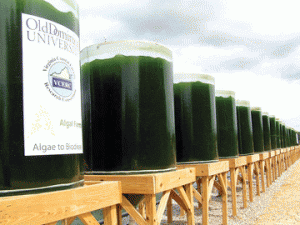Pond Scum Solutions: Turning Pollution Into Fuel

At Old Dominion University, the site of the Virginia Coastal Energy Reserach Consortium, they conduct algal biomass research. Photo by Chuck Thomas. According to DOE’s National Algal Biofuels Technology Roadmap published in May 2010, algae yields approximately 1,000 to 6,500 gallons of oil per acre per year, while soybeans yield a mere 48 gallons per acre per year and oil palm yields about 635 gallons per acre per year.
By Maureen Halsema
The concept is simple—take one of the most effective photosynthetic life forms on earth and put it to work. The secret weapon: algae.
Algae are organisms that grow quickly in aquatic environments via photosynthesis, CO2 and nutrients, and they can be used to produce biomass and biofuel.
Algae have several advantages over food crop biofuels. For instance, an alga grows faster and does not necessitate the use of agricultural land. Farmers can grow algae on land otherwise considered unsuitable for crop production, expanding and diversifying their options. They could even convert algae into biodiesel and use it to fuel their equipment. Algae can actually double in size in one day while other crops may require up to an entire agricultural season to grow.
Algae do not compete with other food sources, preventing escalating food prices as a result of biofuel production. The oil content of algae is also much higher than that of corn and other food-based biofuels.
Algae production faces several technical challenges, however. In terms of commercial production, expense is the biggest obstacle. Researchers are currently exploring a variety of different methods to cost effectively grow, harvest and convert algae into biofuel. From coupling algae cultivation with wastewater cleanup to using the co-products for green fertilizers, researchers are investigating different means to minimize the production costs.
Many petroleum corporations, including Exxon Mobil, Chevron and Shell have been working on algae research and development technology. Exxon Mobil projected that it would spend more than $600 million over the next decade on research and development of algae-based biofuels.
In addition, the U.S. Department of Energy recently dedicated $24 million to algal biofuel research to supplement the $140 million allocated from the American Recovery and Reinvestment Act.
While the upfront costs for algal biofuel production may be high, the external costs are low: this technology is essentially carbon-neutral.
Algae absorb CO2 during their growth process and then release it when the CO2 is burnt for fuel.
“The carbon never disappears. It just changes from a greenhouse gas to a fertilizer or fuel through photosynthesis,” said Bruce Dannenberg, chief executive officer of Plantonix, a North Carolina corporation dedicated to researching and developing a commercially viable production of algal and cyanobacterial biofuels.
While algae production does require large volumes of water, it does not need treated drinking water; ocean water, polluted river water or treated wastewaters are viable options.
Algae can also consume the CO2 necessary for photosynthesis from power plant and industry emissions—as optimal algal growth occurs in a CO2 rich environment. By strategically placing algae farms near existing power plants, a portion of emissions can effectively be recycled into algae growth fuel for biodiesel. Algae can help clean up the environment and provide the fuel and electricity needed to aid the transition from fossil fuels and their damaging environmental impacts.
While many species of algae require consistent sunlight and temperatures, some scientists believe that this biofuel shows great promise in the Southern Appalachian region. The key: using natural native wild algal species that have adapted to the mountain climate over millions of years.
“What you try to do is to use biomimcry, basically, what nature has provided naturally, to your advantage at growing the crop,” said Dannenberg. “You just have to have the right approach and the right strategy. Planktonix is working with Old Dominion University and we have a joint project to develop a practical, cost-competitive commercial approach to get algae and high lipid cyanobacteria adopted regionally as a new energy microcrop.”
Perhaps with some continued research and technological development, Appalachia may play a role in farming algal biofuels.
Crop/ Oil Yield (Gallons/Acre/Year)
Soybean/ 48
Camelina/ 62
Sunflower/ 102
Jatropha/ 202
Oil Palm/ 635
Algae / 1,000-6,000
Related Articles
Latest News

Leave a comment
Your email address will not be published. Required fields are marked *





Leave a Comment